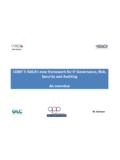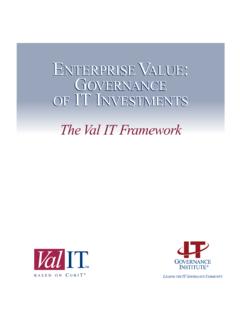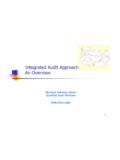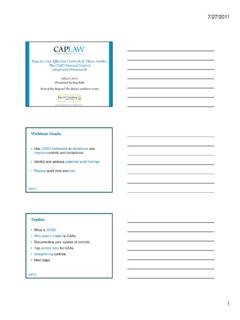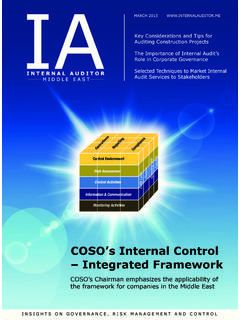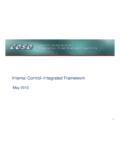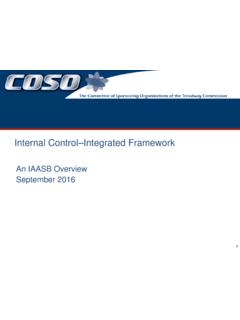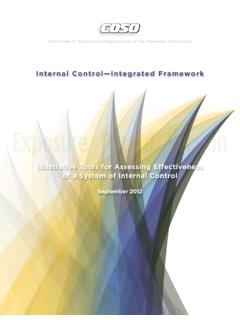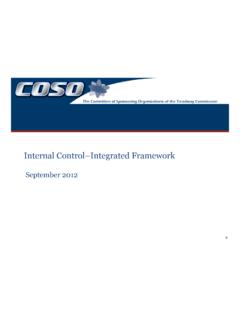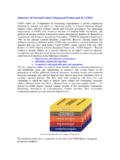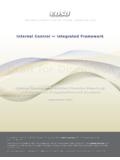Transcription of INTERNAL CONTROL – INTEGRATED FRAMEWORK …
1 Office of INTERNAL AuditingDecember 1999 summary of COSO INTEGRATED FrameworkPage 1 INTERNAL CONTROL INTEGRATED FRAMEWORK (Excerpted from the executive summary of the Report Issued by The Committee of Sponsoring Organizations of the Treadway Commission, 1992)PurposeThe COSO (Committee of Sponsoring Organizations) Report defines INTERNAL CONTROL , describes its components, and provides criteria against whichcontrol systems can be CONTROL is a process, effected by an entity s board of directors, management, and other personnel, designed to provide reasonable assuranceregarding achievement of objectives in the following categories: Effectiveness and efficiency of operations, Reliability of financial reporting, and Compliance with applicable laws and of the Report1. Establish a common definition of INTERNAL CONTROL that serves many different parties, and2. Provide a standard against which organizations can assess their CONTROL systems and determine how to improve ElementsThe INTERNAL CONTROL system consists of five inter-related components:1.
2 CONTROL environment2. Risk assessment3. CONTROL activities4. Information & Communications5. of INTERNAL AuditingDecember 1999 summary of COSO INTEGRATED FrameworkPage 2 AREAASPECTDETAILC ontrolEnvironmentIntegrity & Ethical Values Existence and implementation of codes of conduct and other policies regardingacceptable business practice, conflicts of interest, or expected standards ofethical and moral behavior. Dealings with employees, suppliers, customers, investors, creditors, insurers,competitors, and auditors, etc. ( , whether management conducts business ona high ethical plane, and insists that others do so, or pays little attention toethical issues). Pressure to meet unrealistic performance targets particularly for short-termresults and the extent to which compensation is based on achieving thoseperformance targets. Commitment to Competence Formal or informal job descriptions or other means of defining tasks thatcomprise particular jobs.
3 Analyses of the knowledge and skills needed to perform jobs adequately. Board of Directors or AuditCommittee Independence from management, such that necessary, even if difficult andprobing, questions are raised. Frequency and timeliness with which meetings are held with chief financialand/or accounting officers, INTERNAL auditors and external auditors. Sufficiency and timeliness with which information is provided to board orcommittee members, to allow monitoring of management s objectives andstrategies, the entity s financial position and operating results, and terms ofsignificant agreements. Sufficiency and timeliness with which the board or audit committee is apprisedof sensitive information, investigations and improper acts ( , travel expensesof senior officers, significant litigation, investigations of regulatory agencies,defalcations, embezzlement or misuse of corporate assets, violations of insidertrading rules, political payments, illegal payments).
4 Management s Philosophy andOperating Style Nature of business risks accepted, , whether management often enters intoparticularly high-risk ventures, or is extremely conservative in accepting risks. Frequency of interaction between senior management and operatingOffice of INTERNAL AuditingDecember 1999 summary of COSO INTEGRATED FrameworkPage 3 AREAASPECTDETAIL management, particularly when operating from geographically removedlocations. Attitudes and actions toward financial reporting, including disputes overapplication of accounting treatments ( , selection of conservative versusliberal accounting policies; whether accounting principles have beenmisapplied, important financial information not disclosed, or recordsmanipulated or falsified.) Office of INTERNAL AuditingDecember 1999 summary of COSO INTEGRATED FrameworkPage 4 AREAASPECTDETAIL Organizational Structure Appropriateness of the entity s organizational structure, and its ability toprovide the necessary information flow to manage its activities.
5 Adequacy of definition of key managers responsibilities, and theirunderstanding of these responsibilities. Adequacy of knowledge and experience of key managers in light ofresponsibilities. Assignment of Authority andResponsibility Assignment of responsibility and delegation of authority to deal withorganizational goals and objectives, operating functions and regulatoryrequirements, including responsibility for information systems andauthorizations for changes. Appropriateness of CONTROL -related standards and procedures, includingemployee job descriptions. Appropriate numbers of people, particularly with respect to data processing andaccounting functions, with the requisite skill levels relative to the size of theentity and nature and complexity of activities and systems. Human Resource Policies andPractices Extent to which policies and procedures for hiring, training, promoting andcompensating employees are in place.
6 Appropriateness of remedial action taken in response to departures fromapproved policies and procedures. Adequacy of employee candidate background checks, particularly with regard toprior actions or activities considered to be unacceptable by the entity. Adequacy of employee retention and promotion criteria and information-gathering techniques ( , performance evaluations) and relation to the code ofconduct or other behavioral guidelines. Risk Assessment Objectives Objectives can be set in a structured or informal way; hey may be explicitly orimplicitly stated. They are often represented by the entity s mission and valuestatements. More specific objectives flow from the broad strategy. These are entitylevel objectives that are linked and INTEGRATED with activity level objectives. Office of INTERNAL AuditingDecember 1999 summary of COSO INTEGRATED FrameworkPage 5 AREAASPECTDETAIL Categories of objectives include: Operations objectives, pertaining to effectiveness and efficiency, includingperformance and profitability goals and safeguarding resources against vary based on management s choices about structure and performance.
7 Financial Reporting objectives, which pertain to the preparation of reliablepublished financial statements and driven primarily by external requirements. Compliance objectives, which pertain to adherence to laws and regulationsgoverning the entity. These are dependent on external factors. In some cases,all entities are subject to them, others are industry-specific. Evaluation in this area consists of examining: Entity-wide objectives: Extent to which they provide sufficiently broad statements and guidance onwhat the entity desires to achieve, yet which are specific enough to relatedirectly to this entity. Effectiveness with which the entity-wide objectives are communicated toeemployees and board of directors. Relation and consistency of strategies with entity-wide objectives. Consistency of business plans and budgets with entity-wide objectives, strategicplans and current conditions.
8 Activity-level objectives: Linkage of activity level objectives with each other. Consistency of activity-level objectives with each other. Relevance of activity level objectives to all significant business processes. Specificity of activity level objectives. Adequacy of resources relative to objectives. Identification of objectives thatare important (critical success factors) to achievement of entity-wide objectives. Involvement of all levels of management in objective setting and extent to whichthey are committed to the of INTERNAL AuditingDecember 1999 summary of COSO INTEGRATED FrameworkPage 6 AREAASPECTDETAIL Risk Identification & Analysis Performance can be at risk due to INTERNAL or external factors, which can affecteither stated or implied objectives. An entity s risk assessment process should becomprehensive and consider risks that may occur. All significant interactions ofgoods, services and information should be considered.
9 The risk assessmentprocess is iterative and is usually INTEGRATED with the planning process. Entity-level risks Adequacy of mechanisms to identify risks arising from such external factors as thefollowing: Technological developments Changing customer needs or expectations Competition New legislation or regulation Natural catastrophes Economic changes Adequacy of mechanisms to identify risks arising from such INTERNAL factors as thefollowing: Disruption in information systems Quality of personnel hired and methods of training and motivation Change in management responsibilities Nature of the entity s activities and employee accessibility to assets Unassertive or ineffective board or audit risksIdentification of significant risks for each significant activity-level objective. Forany objective, many risks can be identified. Potential causes for failing to meetOffice of INTERNAL AuditingDecember 1999 summary of COSO INTEGRATED FrameworkPage 7 AREAASPECTDETAIL objectives can range from the obvious to the obscure and from the significant to theinsignificant in potential effect.
10 To avoid overlooking relevant risks, theidentification of potential risk is best made separately from the likelihood of therisk and relevance of the risk analysis process, including: Estimating the significance of a risk Assessing the likelihood of the risk occurring Considering how the risk should be of INTERNAL AuditingDecember 1999 summary of COSO INTEGRATED FrameworkPage 8 AREAASPECTDETAIL Managing Change Every entity needs to have a process, formal or informal, to identify conditions thatcan significantly alter its ability to achieve objectives, including changes in thestatus quo. Reasonable mechanisms should be in place to anticipate changes thatcan affect the entity s performance either by avoiding problems or by takingadvantage of opportunities. Changed circumstances that demand special attention: Changed operating environment New personnel New or revamped information systems Rapid growth New technology New lines, products, activities Corporate restructurings Foreign operationsOffice of INTERNAL AuditingDecember 1999 summary of COSO INTEGRATED FrameworkPage 9 AREAASPECTDETAILC ontrolActivitiesPolicies and ProceduresPolicies (which establish what should be done) and procedures (the actions ofpeople to carry out policies) help ensure that management directives identified asnecessary to address risks are carried out.
